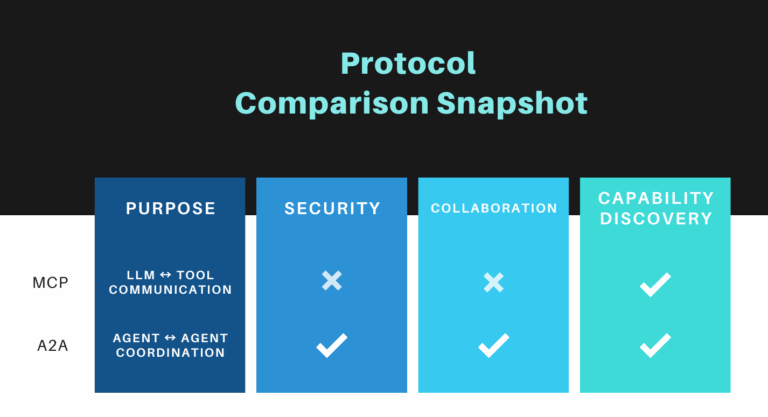The Future of Multi-Agent AI: Inside Google’s A2A Protocol
Imagine a future where intelligent agents do not merely execute tasks, they coordinate, negotiate, and collaborate like a team of digital coworkers. That future may be closer than anticipated.
Google recently unveiled a new protocol called A2A (Agent-to-Agent), a significant step toward standardizing how autonomous agents interact. This development raises an important question: What differentiates A2A from the existing MCP (Model Context Protocol)?
Meet MCP: The Foundation of LLM-Tool Interaction
The Model Context Protocol (MCP) has quietly become the default protocol for enabling large language model (LLM)-based applications to access various tools, services, and data sources. MCP defines how applications structure and interpret interactions with model-context, like giving ChatGPT a plug-and-play toolkit for the real world.
The MCP foundation includes the following components:
- Host: An LLM-powered program that initiates interaction
- Client: A program that communicates directly with a server
- Server: Offers specific capabilities in a uniform format (e.g. search, summarize, translate)
- Local sources: Files, databases, or utilities on your personal device
- Remote sources: Public APIs or online platforms
In essence: MCP is the glue that connects models to tools. However, it was never designed for agents-to-agent communication.
Now Enter A2A: A Protocol for Agent Ecosystems
This is where Google’s A2A protocol makes its entrance. Unlike MCP, the new A2A protocol is not focused on LLMs using tools—it’s designed for intelligent agents to collaborate. Imagine digital assistants that can coordinate tasks, share context, and adjust behavior—all without human intervention.
Core pillars of A2A include:
- Secure identity: Built-in authentication and trust mechanisms between agents
- State awareness: Dynamic content updates and sharing
- Task delegation: Fluid transfer of responsibilities between agents
- Capability discovery: Real-time identification of peer capabilities
- Experience tuning: Workflow adaption based on agent or user preferences
Ultimately, A2A does not replace MCP. Rather, it addresses what MCP never intended to support.
Competing or Complementary?
While some view A2A and MCP as competing protocols, reality paints a more collaborative picture:
- MCP focuses on single-agent interaction with tools.
- A2A enables multiple agents to collaborate and orchestrate.
In fact, agents built using MCP at their core could evolve into A2A-compatible nodes, enabling hybrid systems that leverage the strengths of both frameworks.
Consider MCP as the electrical wiring of a smart home, while A2A is the language the devices in the home use to negotiate, synchronize, and plan events.
Protocol Comparison Snapshot

Why It All Matters
This shift is more than engineering nuance.
The emergence of A2A unlocks autonomous agent networks that can:
- Coordinate across business systems
- Solve problems collectively
- Manage tasks adaptively with minimal oversight
Whether A2A becomes the new standard or coexists with MCP, gent-based artificial intelligence is transitioning from siloes to intelligent, collaborative ensembles. The next AI leap will not be driven by a single, smarter model, it will emerge from a smarter system of models, communicating and working together effectively and efficiently.
